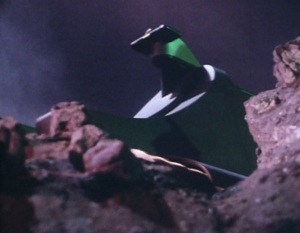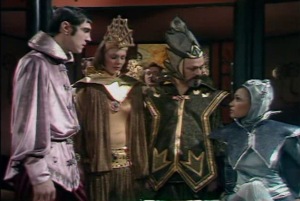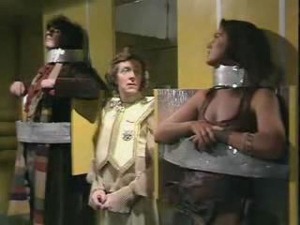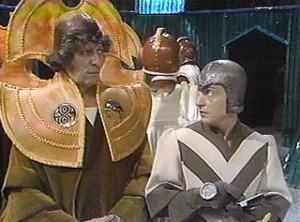Fear, Assassin, Evil, Death – there’s certainly a dark thread running through the titles in this season!
A writer of crime drama and science fiction, Chris Boucher returns to write another Doctor Who story, successfully merging the two genres into one. This is a Whodunit (hehe, “Who”, geddit?) with robots, a crew of rich miners, set aboard a massive land vehicle drilling machine. In short, I loved it.
The robots in question are scarcely more than men in foil suits, but their blank masked faces and calm, soothing voices make them frightening killers, particularly in a society that deems the very notion of violent robots to be impossible. There’s a great explanation of “robophobia”, which is where a lack of body language is at odds with the humanoid appearance, leading to paranoia and anxiety in some people, including one of the poor characters here.
You’ve got to have likeable, or at least identifiable, characters when you make a murder mystery story, and The Robots of Death manages to achieve this where embarrassingly modern blockbusters like Prometheus fall flat on their face. Despite being a bunch of slightly snobby wealthy people, they have unique traits, natural dialogue and come across likeable and sympathetic. Meanwhile, new companion Leela is headstrong and feisty – I like her.
As well as a riveting mystery, this also has rather excellent production values. The use of miniatures is sadly unconvincing but is at least ambitious, and the sets are better than most so far. One minor complaint is the use of shiny metal materials – they do not react well on video. There’s regular splotches of colour as they reflect the studio lights. Another minor complaint is that the Doctor yet again arrives somewhere just as danger is happening, and gets accused of causing it, but they actually make a joke about it, which is self-referential enough to get a free pass.
Speaking of humour, there’s an amusing scene in the Tardis at the start in which the Doctor explains how it can be bigger inside, using a big cube and small cube, which is basically the opposite of that scene from Father Ted with the cows. The Doctor is pretty great in this one, calmly smiling at death with a wit and charm that I can’t see any of the other Doctors managing to pull off. All of this despite a rather violent tone, plenty of stranglings and robots with creepy red eyes calmly announcing they’re about to kill, kill, kill. Amusingly, the mastermind is defeated by helium – brilliant!
Lovely stuff. I thoroughly enjoyed it.









































